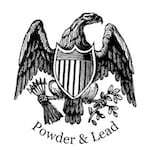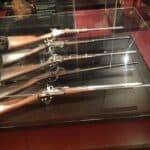
Introduction
Among the lesser-known but technically refined firearms of the American Civil War, the Ball & Williams Ballard Carbine stands out for its mechanical simplicity, precision, and transition-era engineering. While overshadowed in numbers by the Sharps, Spencer, and Burnside carbines, the Ballard was one of the most accurate and well-machined single-shot percussion arms fielded during the conflict. Designed by Charles H. Ballard and initially produced by the firm of Ball & Williams of Worcester, Massachusetts, the Ballard Carbine embodied a convergence of practical design and manufacturing quality in an era crowded with experimental arms.
This article offers the most complete and factual history available of the Ballard Carbine's invention, technical development, government contracts, battlefield service, postwar conversions, and modern collector interest. Built to meet the standards of both historical accuracy and digital search visibility, it also integrates source-based clarifications and deeper contextual analysis.
Charles H. Ballard and the 1861 Patent
The Ballard Carbine mechanism was the work of Charles Henry Ballard of Worcester County, Massachusetts. Known for his craftsmanship and engineering insight, Ballard patented a novel breech-loading, single-shot rifle mechanism on November 5, 1861 (U.S. Patent No. 33,158). His design featured a pivoting breechblock operated by a simple lever beneath the receiver. The system allowed rapid rear loading of a linen or paper cartridge, secured by a falling block which sealed the chamber effectively and resisted fouling.
Ballard’s invention emphasized economy of motion and manufacturing. The block dropped vertically within a solid receiver, locking securely and resisting the kind of blowback that plagued open-chamber systems. It used a fixed barrel, deep rifling, and tight breech sealing—all of which contributed to its high performance. Unlike contemporaries experimenting with bolt actions or break-open systems, Ballard opted for mechanical economy. His mechanism was elegant in its strength and simplicity, employing fewer moving parts than most Union carbines of the day.
Ball & Williams of Worcester: Origin of Military Production
The original military production of the Ballard Carbine began under the partnership of Charles W. Ball and William B. Williams, whose Worcester-based firm, Ball & Williams, secured licensing to manufacture the design in late 1861. Neither man was related to Charles H. Ballard, though they shared his commitment to fine machining and quality control.
Ball & Williams produced approximately 3,000 to 5,000 military-pattern carbines between 1862 and 1865. These were chambered in .54 caliber and configured for percussion ignition. Compared to mass-produced counterparts, the Ballard Carbine was built to tight tolerances, with well-finished components and consistent parts fit. Most examples bear serial numbers below 5,000 and are clearly marked with the firm's name: “BALL & WILLIAMS / WORCESTER, MASS.” on the left side of the receiver.
The firm received U.S. government contracts for the Ballard Carbine through indirect channels. Much of its output was delivered to state militias under federal authorization, while other lots were distributed via emergency procurement to cavalry units. Notably, the Kentucky State Guard acquired Ballard Carbines through the Ordnance Department and private channels. Surviving carbines and documentation suggest that limited numbers were issued to Union cavalry units operating in the Western Theater, including possible trials by the 9th Michigan Cavalry. Additional small contracts—potentially as low as 100–200 carbines—were filled for use by the U.S. Navy.
Technical Specifications and Operation
The Ballard Carbine was admired for its simplicity, strength, and ease of use. It featured a solid frame and a centrally pivoting breechblock actuated by a curved finger lever. Unlike many contemporaries, it was highly resistant to fouling and required minimal disassembly for cleaning.
Standard Military Configuration:
- Caliber: .54 percussion
- Barrel Length: 22 inches
- Overall Length: Approx. 39 inches
- Weight: 6.8 to 7.2 lbs (specimen-dependent)
- Rifling: Six grooves, right-hand twist, approx. 1:24" rate
- Sights: Front blade, rear V-notch adjustable
Mechanical Function:
Operating the Ballard Carbine was intuitive. Lowering the lever dropped the breechblock and exposed the chamber. The shooter inserted a paper or linen cartridge—typically pre-packaged with powder and bullet—and capped the cone with a standard percussion cap. Closing the lever sealed the breech. The hammer was then cocked and the weapon fired. Reloading took place quickly, even under stress. The solid receiver and tight tolerances limited gas blowback and maintained consistent ballistic performance.
The action’s reliability, combined with its strong lockup, made it suitable for heavy use in field conditions. Unlike the Maynard or Gallagher, it did not rely on auxiliary locking mechanisms or case obturation—its mechanical precision alone ensured consistent firing.
Ammunition and Ballistics
Military-issued Ballard Carbines used linen or paper cartridges containing 50–55 grains of black powder and a .535" to .540" diameter conical bullet. These were typically lubricated with tallow or beeswax to ease chambering and minimize leading.
- Powder Charge: 50–55 grains FFg
- Bullet Weight: Approx. 400 grains
- Muzzle Velocity: 950–1,100 fps
- Muzzle Energy: Up to 1,050 ft-lbs
Cartridges were produced by government arsenals and private contractors such as D.C. Sage. Some specimens survive with foil bases or wax-sealed tails, indicating experimentation with waterproofing and long-term storage.
Cavalry Use and Regiment Distribution
Though never a mass-issue weapon, the Ballard Carbine saw meaningful deployment in specific contexts:
- Kentucky State Guard and Border Units: These organizations received Ballards directly and through federal support, with carbines used extensively in skirmishes along the Ohio River and in guerrilla suppression.
- 9th Michigan Cavalry (possible trials): Some records and surviving arms point to field trials or limited issuance.
- Western Theater Units: The Ballard’s utility in dismounted fighting and skirmishing made it a suitable second-line or sharpshooter’s weapon.
- U.S. Navy Bureau of Ordnance (1864): A small order was accepted, though it is unclear whether these carbines were deployed to naval infantry, gunboat crews, or held in depot.
Officer accounts from Western campaigns praise the Ballard’s reduced fouling and sustained accuracy over extended firing. Its shorter length and lighter weight made it especially useful in dense brush, river operations, and outpost duties.
Decline of Military Production and the Marlin Renaissance
With the end of the Civil War in 1865, government demand plummeted. Ball & Williams dissolved shortly thereafter. The manufacturing rights passed to Dwight, Chapin & Co., another Worcester firm, but that venture was short-lived.
In 1870, J.M. Marlin acquired the rights and began producing the Ballard rifle in expanded form. Marlin-era Ballards became some of the most beloved and widely used single-shot rifles in America. Over two dozen variants were produced, with calibers ranging from .22 rimfire to .45-100, including popular models for buffalo hunting, Schuetzen competitions, and match shooting.
While visually similar, Marlin Ballards were generally centerfire, with improved metallurgy, set triggers, and optional double-set triggers or spirit-level front sights.
Collectibility and Surviving Carbines
Ball & Williams-marked percussion Ballards are rare. Serial numbers under 5,000 confirm early wartime production. Inspector cartouches on the left stock flat are found on federally inspected models, typically with single initials such as "JT" or "ADK."
- Condition Matters: Most carbines exhibit field wear, bore erosion, and weathered stocks. Excellent-condition examples with clear markings and unaltered configurations command a premium.
- Auction Values: Prices in premier auctions range from $2,500 to over $8,000 depending on condition, markings, and provenance.
- Known Examples: Public collections housing Ballard Carbines include the Springfield Armory National Historic Site and the National Museum of American History.
Reenactment and Shooting Today
With appropriate inspection, original percussion Ballards can be safely fired. Shooters often use hand-rolled cartridges or reusable nitrated paper tubes with soft-lead bullets.
Typical Load for Reproduction Use:
- 50 grains FFg Goex or Swiss black powder
- .535"–.540" pure lead bullet, 400–410 grains
- Lubricated felt wad optional
- #11 percussion cap
Some enthusiasts use brass cases formed to fit the chamber for reduced fouling and easier cleanup, though care must be taken not to overpressure the original steel.
Conclusion
The Ball & Williams Ballard Carbine was not the most common firearm of the Civil War—but it was among the best made. Combining precision machining, ease of use, and outstanding accuracy, it represented a forward-looking departure from overcomplicated percussion carbines of the time.
Its impact extended far beyond its 3,000–5,000 wartime examples. The Ballard mechanism became a touchstone of American single-shot design—refined, durable, and mechanically elegant. Though its role in the war was limited, its engineering excellence shaped a generation of postwar rifles.
Today, the Ballard stands as both artifact and inspiration. In museums, on collector walls, and at blackpowder matches, it continues to tell a story of Yankee ingenuity, wartime adaptation, and lasting mechanical brilliance.

If you know of any forums or sites that should be referenced on this listing, please let us know here.



